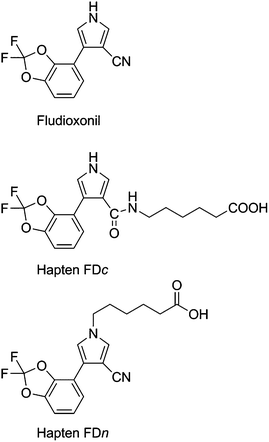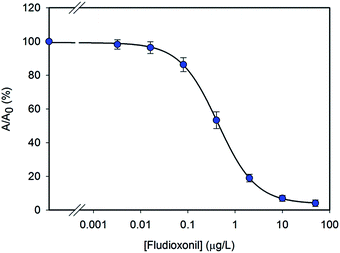 Open Access Article
Open Access ArticleCreative Commons Attribution 3.0 Unported Licence
Development of a sensitive and specific enzyme-linked immunosorbent assay for the determination of fludioxonil residues in fruit juices
Josep V.
Mercader
a,
Antonio
Abad-Fuentes
a,
Consuelo
Agulló
b,
Antonio
Abad-Somovilla
*b and
Francesc A.
Esteve-Turrillas
*a
aDepartment of Biotechnology, Institute of Agrochemistry and Food Technology, Consejo Superior de Investigaciones Científicas (IATA-CSIC), Agustín Escardino 7, 46980 Paterna, Spain. E-mail: faet@iata.csic.es; Fax: +34-963636301; Tel: +34-963900022
bOrganic Chemistry Department, University of Valencia, Doctor Moliner 50, 46100 Burjassot, Spain. E-mail: antonio.abad@uv.es; Fax: +34-963544328; Tel: +34-963544509
First published on 15th September 2014
Abstract
Fludioxonil is a fungicide with a singular mode of action that is widely employed in the treatment of fruit crops. A competitive enzyme-linked immunosorbent assay (cELISA) has been developed and validated for the determination of residues of this fungicide in fruit juices. A collection of monoclonal antibodies (mAbs) against the fungicide fludioxonil has been produced and characterized using direct and indirect cELISAs. The high affinity achieved (IC50 lower than 0.5 μg L−1) considerably improved that obtained with previous polyclonal antibodies. The proposed cELISA was applied to the analysis of fludioxonil residues in apple juice and red grape must samples with a limit of quantification of 5 and 10 μg L−1, respectively. A validation of the method has been performed in terms of sensitivity, selectivity, trueness, precision, and robustness. Finally, blind-spiked samples were measured by the proposed cELISA and by a gas chromatography-mass spectrometry (GC-MS) method, with equivalent results by both methodologies.
1 Introduction
Fludioxonil (4-(2,2-difluoro-1,3-benzodioxol-4-yl)-1H-pyrrole-3-carbonitrile) is a non-systemic and broad-spectrum fungicide with a mode of action based on the inhibition of a mitogen-activated protein kinase in signal transduction of osmoregulation.1 This fungicide strongly interferes with mycelia growth and conidial germination of two of the most prevalent post-harvest rots: Botrytis cinerea in grapes2 and Penicillium expansum in apples.3 Fludioxonil is commercialized by Syngenta under different trade names either alone or co-formulated with other fungicides, such as cyprodinil or metalaxyl, and it has been registered in the European Union for the treatment of diseases affecting a lot of crops.1 Measurable levels of fludioxonil are often found in many fruits and vegetables, and occasionally these levels are above the established maximum residue levels (MRLs); residues have been found even in organic food such as potatoes, carrots or raspberries.4 Analytical methodologies for the determination of fludioxonil in food are mostly based on organic solvent extraction followed by chromatographic separation (gas or liquid) with mass spectrometry detection.5–8 The multiresidue QuEChERS (Quick, Easy, Cheap, Effective, Rugged, and Safe) method, based on buffered acetonitrile extraction, has proved to be highly efficient for the quantitative extraction of fludioxonil in vegetables and fruits.9,10The use of immunoassays for the determination of fungicide residues in food is steadily growing, and the number of agrochemicals for which sensitive, selective, simple, rapid, and portable immunochemical methods have been reported increases year after year. Recent examples include picoxystrobin in beer,11 diniconazole in agricultural samples,12 fenhexamid in fruits,13 azoxystrobin in fruits and vegetables,14 kresoxim-methyl in vegetables,15 or tetraconazole in fruit juices.16 Our group has recently described the synthesis of the first functionalized derivatives mimicking fludioxonil (haptens FDn and FDc; Fig. 1) and the generation of rabbit polyclonal antibodies to this fungicide. These antibodies exhibited a moderate affinity to fludioxonil, with IC50 values in competitive assays ranging from 6 μg L−1 to 380 μg L−1.17 The aim of this study is the development of a cELISA sensitive enough to allow the determination of fludioxonil residues in fruits at regulatory levels. For this purpose, monoclonal antibodies (mAbs) were produced by using as immunogens bioconjugates of the haptens FDn and FDc. The collection of mAbs was characterized by cELISA using direct and indirect formats, and the most sensitive assay was applied and validated for the analysis of fludioxonil residues in apple juice and red grape must samples.
2 Experimental
2.1 Reagents and instrumentation
Fludioxonil and other fungicide standards were purchased from Fluka/Riedel-de-Haën (Seelze, Germany) and Dr Ehrenstorfer (Augsburg, Germany). Costar flat-bottom high-binding polystyrene ELISA plates were from Corning (Corning, NY, USA). Ultraviolet-visible spectra and ELISA absorbances were read with a PowerWave HT from BioTek Instruments (Winooski, VT, USA). ELISA plates were washed with an ELx405 microplate washer from BioTek Instruments. Polyclonal rabbit antibody anti-mouse immunoglobulins conjugated to peroxidase (RAM-HRP) were from Dako (Glostrup, Denmark). Ethanol and acetonitrile were obtained from Scharlau (Barcelona, Spain). O-Phenylenediamine (OPD) and triphenyl phosphate (TPP) were purchased from Sigma-Aldrich (Madrid, Spain). Hydrogen peroxide (30%), sulphuric acid (95%) and buffer constituents were purchased from Prolabo-VWR International Eurolab S.L. (Barcelona, Spain). A primary secondary amine (PSA) solid phase from Varian (Lake Forest, CA, USA) was employed for juice clean-up. An Agilent Technologies (Santa Clara, CA, USA) 6890N GC network system, equipped with a 7683 Series autosampler, a HP-5MS (30 m × 0.25 mm × 0.25 μm) capillary column, and a 5973 mass selective detector, was employed for chromatographic determinations.The composition, concentration and pH of the employed buffers are: (i) PB, 100 mM sodium phosphate buffer (pH 7.4); (ii) PBS, 10 mM sodium phosphate buffer (pH 7.4) with 140 mM NaCl; (iii) PBST, PBS containing 0.05% (v/v) Tween 20; (v) CB, 50 mM carbonate-bicarbonate buffer (pH 9.6); (vi) washing solution, 150 mM NaCl and 0.05% (v/v) Tween 20; and (vii) substrate buffer, 25 mM citrate and 62 mM sodium phosphate buffer (pH 5.4).
The haptens FDn and FDc and their respective ovalbumin (OVA), bovine serum albumin (BSA), and horseradish peroxidase (HRP) protein conjugates were prepared, purified and characterized as previously described.17 Hapten-to-protein molar ratios of the aforementioned conjugates were 2, 15, and 6 for OVA, BSA, and HRP, respectively, in the case of hapten FDc, and 2, 17, and 4 for OVA, BSA, and HRP, respectively, in the case of hapten FDn.
2.2 Monoclonal antibody production
Animal manipulation was performed in compliance with the laws and guidelines of the Spanish Ministry of Agriculture, Food, and Environment, and approved by the Ethics Committee of the Universitat de València. Two groups of four BALB/c female mice (8–10 weeks old) were immunized by intraperitoneal injections with conjugates BSA-FDc and BSA-FDn. Injections consisted of an emulsion of 100 μL of 1 g L−1 conjugate in PB and 100 μL of Freund's adjuvant. The first dose contained complete Freund's adjuvant, and subsequent doses were given at weeks 3 and 6 using incomplete Freund's adjuvant. Mice received a booster injection of 100 μg of the immunogen in PBS three days before cell fusion.Murine myeloma cells and spleenocytes from immunized mice were fused using standard procedures.18 Twelve days after fusion, hybridoma culture supernatants were screened by simultaneous indirect non-competitive and competitive ELISAs to identify the best binders. The selected hybridomas were cloned twice, expanded and cryopreserved in liquid nitrogen. Immunoglobulins were purified from late stationary phase culture supernatants by ammonium sulfate precipitation and protein G affinity chromatography. Purified antibodies were aliquoted and kept at 4 °C in amber vials for daily usage.
2.3 Direct cELISA
Ninety-six-well polystyrene plates were coated with 100 μL of mAb diluted in CB, and plates were incubated overnight at room temperature. Coated plates were washed four times with washing solution and received, afterwards, 50 μL per well of analyte in PBS plus 50 μL per well of HRP-FDn tracer solution in PBST. The immunological reaction took place during 1 h at room temperature, and then plates were washed as described above. Finally, a signal was developed by addition of 100 μL per well of freshly prepared 2 g L−1o-phenylenediamine solution containing 0.012% (v/v) H2O2 in substrate buffer. The enzymatic reaction was stopped after 10 min at room temperature by addition of 100 μL per well of 2.5 M sulphuric acid. The absorbance was immediately read at 492 nm with a reference wavelength at 650 nm.2.4 Indirect cELISA
ELISA plates were coated with 100 μL per well of OVA-FDn or OVA-FDc solution in CB by overnight incubation at room temperature. Coated plates were washed as described before and then each well received 50 μL of analyte in PBS plus 50 μL of mAb in PBST. The immunological reaction took place during 1 h at room temperature and plates were washed again. Next, 100 μL per well of a 1/2000 dilution of the RAM-HRP conjugate in PBST was added, and plates were incubated for 1 h at room temperature. After washing the plates, a signal was generated as detailed in Section 2.3.2.5 Data treatment
Eight-point standard curves were prepared from 50 μg L−1 fludioxonil by 5-fold serial dilution in PBS, including a blank. Experimental values were fitted to a four-parameter logistic equation using the SigmaPlot software package from SPSS Inc. (Chicago, IL, USA). Assay sensitivity was defined as the concentration of the analyte at the inflection point of the fitted curve, typically corresponding to a 50% inhibition (IC50) of the maximum absorbance (Amax). The limit of detection (LOD) was calculated as the concentration of the analyte at a 10% inhibition of Amax. The linear range was estimated as the concentration range of the analyte between 10 and 90% inhibition of Amax.2.6 Ionic strength, pH and solvent studies
The influence of buffer ionic strength and pH over the inhibition curve of the immunoassay was evaluated running the assay in different buffers with pH values between 5.5 and 8.0, and ionic strength from 50 to 300 mM. A set of buffers with varied ionic strengths was prepared using 10 mM sodium phosphate buffer (pH 7.4), 0.05% (v/v) Tween 20 and different amounts of 2 M NaCl in order to reach the intended ionic strength values. The set of varied pH buffers was prepared from a mixture of salts (10 mM trisodium citrate, disodium hydrogen phosphate and Tris) where 5 M HCl was added to cover the whole range of assayed pH values. The ionic strength of solutions was adjusted to 175 mM with 2 M NaCl and 0.05% (v/v) Tween 20 was also added.The influence of solvents over the performance of the proposed immunoassay was evaluated using fludioxonil standard curves prepared in the presence of ethanol and acetonitrile at different concentrations from 0.5 to 5% (v/v) in water and the mAb solution was prepared in PBST 2×.
2.7 Reference method
The QuEChERS method (AOAC International official method) was employed for the extraction of fludioxonil fungicide from blind-spiked juice samples.19 A 5 mL sample, plus 50 μL internal standard (TPP 50 mg L−1), was introduced into a 15 mL polypropylene centrifuge tube containing 0.5 g sodium acetate and 2 g anhydrous magnesium sulfate. The sample was then extracted with 5 mL of 1% (v/v) acetic acid in acetonitrile by vortexing (1 min), and centrifuged for 5 min at 2200 × g. Then, 1 mL of the extract was introduced into a 2 mL polypropylene centrifuge tube containing 50 mg PSA and 150 mg magnesium sulfate anhydrous, vortexed for 1 min and centrifuged for 5 min at 2200×g. Finally, the purified extract was filtered through a 0.22 μm Teflon filter and analyzed by gas chromatography-mass spectrometry (GC-MS) as follows. One microliter of purified extract was injected in splitless mode at 300 °C by employing helium as a carrier with a constant flow of 1 mL min−1. The oven temperature (150 °C) was held for 1 min, increased at a rate of 10 °C min−1 up to 280 °C, and then kept constant for 5 min. The transfer line and source temperatures were 280 °C and 250 °C, respectively. Electron impact ionization at 70 eV was used and the employed quantification ions were 248 and 249 m/z for fludioxonil, and 325 and 326 m/z for TPP.3 Results and discussion
3.1 Antibody generation and characterization
Two-cell fusion experiments were carried out with splenocytes from mice immunized with each immunogen. With the bioconjugate BSA-FDc, antibodies displaying good binding (IC50 < 100 nM) to fludioxonil in solution were not identified. This outcome is in agreement with the behaviour observed when the same immunogen was used in previous studies to obtain polyclonal antibodies in rabbits,17 thus confirming that fludioxonil derivatives with the linker at the cyano-moiety of the fungicide framework poorly exposed the fludioxonil structure to the immune system. Conversely, from mice immunized with the conjugate BSA-FDn, numerous positive hybridomas able to strongly bind fludioxonil in solution were identified. Following a careful study with 60 selected supernatants, six hybridoma cell lines were finally chosen for further cloning and antibody production.These six new mAbs, named FDn#23, FDn#114, FDn#117, FDn#118, FDn#119 and FDn#131, were characterized, after being purified by affinity chromatography by using a checkerboard competitive analysis using direct and indirect cELISA formats. For direct assays, plates were coated with 1 mg L−1 of mAb in CB and the next day a range of HRP-FDn tracer concentrations (from 1 to 300 μg L−1) was evaluated under competitive conditions. For indirect assays, plates were coated with the OVA-FDn conjugate at 100 or 1000 μg L−1 and the competitive step was carried out using a range of mAb solutions (from 1 to 300 μg L−1). Thus, one inhibition curve was obtained for every aforementioned immunoreagent combination in both cELISA formats. Table 1 shows a summary of the results of the competitive checkerboard study, containing the conditions and main parameters of the best inhibition curve for all evaluated immunoreagent combinations. A high sensitivity was obtained for all assays, with IC50 values lower than 1 μg L−1 for most cases, thus considerably improving the analytical performance of the previous immunoassays developed with polyclonal antibodies, which exhibited IC50 values from 6 to 380 μg L−1.17 Interestingly, no mAb was able to bind FDc-based conjugates, so heterologous immunoassays could not be developed.
| mAb | Direct assay | Indirect assay | ||||||
|---|---|---|---|---|---|---|---|---|
| [mAb] (μg L−1) | [HRP-FDn] (μg L−1) | A max | IC50 (μg L−1) | [mAb] (μg L−1) | [OVA-FDn] (μg L−1) | A max | IC50 (μg L−1) | |
| FDn#23 | 1000 | 30 | 1.67 | 0.87 | 50 | 100 | 1.25 | 0.43 |
| FDn#114 | 1000 | 30 | 1.81 | 0.57 | 100 | 100 | 1.08 | 0.55 |
| FDn#117 | 1000 | 10 | 1.58 | 2.46 | 10 | 1000 | 1.25 | 1.64 |
| FDn#118 | 1000 | 10 | 1.51 | 0.72 | 100 | 100 | 0.99 | 0.52 |
| FDn#119 | 1000 | 10 | 1.36 | 0.77 | 30 | 1000 | 1.43 | 0.82 |
| FDn#131 | 1000 | 30 | 1.57 | 0.69 | 30 | 100 | 1.16 | 0.65 |
The best sensitivity was obtained with mAb FDn#23 in the indirect format (IC50 = 0.4 μg L−1), so this assay was chosen for further work. The corresponding inhibition curve and particular conditions for this assay are shown in Fig. 2. This assay showed a LOD of 0.06 μg L−1 and a linear range from 0.06 to 3.28 μg L−1.
3.2 Assay selectivity
Cross-reactivity studies were performed in order to figure out whether other compounds potentially present in food samples may interfere with the proposed cELISA. Twenty-two widely used fungicides (cyprodinil, kresoxim-methyl, trifloxystrobin, pyraclostrobin, azoxystrobin, dimoxystrobin, fluoxastrobin, metominostrobin, picoxystrobin, fenhexamid, captan, mepanipyrim, pyrimethanil, procimidone, tolylfluanid, cyazofamid, tebuconazole, fenamidone, boscalid, vinclozolin, imidacloprid and benzanilide) were assayed in order to check for interference. Calibration curves were prepared from 1 μg L−1 with every fungicide and assayed by the proposed immunoassay. No inhibition was observed with any of the tested fungicides, so no interference from other fungicides is expected to be found using the proposed assay in the determination of fludioxonil residues in fruit samples; remarkably, this also applies to cyprodinil, an anilinopyrimidine fungicide that is included in the commercial formulation Switch (25.0% (w/w) fludioxonil and 37.5% (w/w) cyprodinil).3.3 Assay robustness
The influence of buffer composition over the inhibition curve was evaluated in order to determine the robustness of the proposed assay. Variation of the main inhibition curve parameters (Amax and IC50) with the ionic strength and pH is shown in Fig. 3 (upper part). Overall, Amax and IC50 values remained essentially unchanged for small variations in buffer composition. Changes in the pH did not greatly modify the inhibition curve, while the use of low ionic strength buffers (lower than 100 mM) provided a noticeable increase of Amax and IC50 values. Accordingly, standards and samples should be run in buffers of ionic strength similar or superior to that of PBS.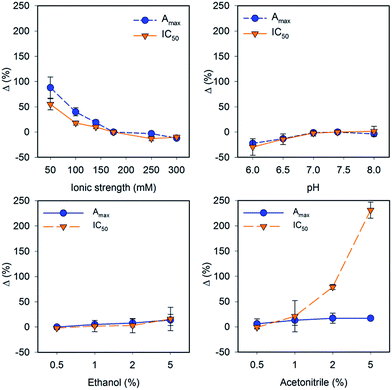 | ||
| Fig. 3 Variation of maximum absorbance (Amax) and sensitivity (IC50) of the indirect cELISA based on mAb FDn#23 with buffer ionic strength, buffer pH, and the presence of ethanol and acetonitrile. | ||
3.4 Solvent tolerance
The analytical parameters of an immunoassay can be modified by the presence of solvents in the extract of the sample to be analysed. Solvents mainly occur in samples because they are used for extraction of the analyte in the previous steps; however, processes like fermentation may provide small amounts of ethanol to some commodities. The influence of ethanol and acetonitrile over the Amax and IC50 values of the proposed immunoassay was investigated, and results are shown in Fig. 3 (bottom part). Ethanol was well tolerated by the proposed assay, whereas concentrations higher than 2% (v/v) acetonitrile provided a clear increase of IC50 values.3.5 Determination of fludioxonil in fruit juices
Apple juice and red grape must samples were selected due to the intensive use of fludioxonil to treat diseases affecting fruit trees and vines. Although sample constituents may affect the immunoassay response, a previous dilution in water or buffer is a common and efficient strategy to minimize the matrix interference. Fludioxonil standard curves (from 50 μg L−1, 5-fold dilution factor) were run in each fruit juice diluted in deionized water (1/5, 1/15, 1/50, 1/150 and 1/500) and antibody solution was prepared in 2× PBST. As it can be seen in Fig. 4, where the most significant dilutions are depicted, the standard curve run in apple juice diluted 1/15 perfectly match the curve run in buffer, whereas the red grape must should be diluted 1/50 in order to avoid interference from the matrix.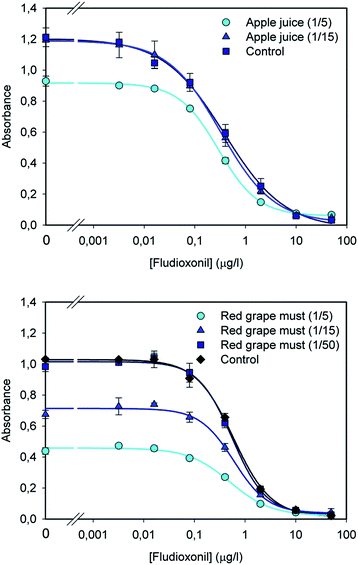 | ||
| Fig. 4 Inhibition curves of the proposed assay obtained at different dilutions of apple juice and red grape must. | ||
The trueness of the proposed assay was evaluated by spiking fludioxonil-free juice samples with known amounts of this fungicide from 5 μg L−1 to 5 mg L−1. Fortified samples were adequately diluted with deionized water before immunoassay determination. Fludioxonil recoveries from 105 to 118% for apple juice, and from 103 to 132% for red grape must were found (Table 2). Relative standard deviations (RSDs) were in most cases lower than 20%. The limit of quantification (LOQ) for the determination of fludioxonil residues in fruit juices was set at the minimum spiked concentration that afforded recovery values comprised between 80 and 120% with RSD values lower than 20%. Thus, the proposed assay achieved LOQs of 5 and 10 μg L−1 for apple juice and red grape must, respectively. Although no specific tolerance has been proposed for fruit juices, the European Union has established the MRLs of fludioxonil in pome fruits and grapes at 5 mg kg−1;20 accordingly, the proposed method has large enough sensitivity to be employed for the analysis of fludioxonil residues in monitoring studies.
| Sample | Spiked (μg L−1) | Dilution | Found (μg L−1 ± s) | Recovery (%) | RSD (%) |
|---|---|---|---|---|---|
| Apple juice | 5 | 1/15 | 5.2 ± 0.3 | 105 | 5 |
| 10 | 1/15 | 11 ± 1 | 112 | 13 | |
| 50 | 1/15 | 53 ± 7 | 106 | 14 | |
| 100 | 1/15 | 110 ± 20 | 114 | 19 | |
| 500 | 1/150 | 590 ± 80 | 118 | 15 | |
| 1000 | 1/150 | 1100 ± 100 | 112 | 15 | |
| 5000 | 1/500 | 5900 ± 200 | 117 | 4 | |
| Red grape must | 5 | 1/50 | 7 ± 2 | 132 | 42 |
| 10 | 1/50 | 11 ± 2 | 113 | 16 | |
| 50 | 1/50 | 55 ± 9 | 110 | 18 | |
| 100 | 1/50 | 100 ± 20 | 103 | 17 | |
| 500 | 1/150 | 520 ± 30 | 105 | 6 | |
| 1000 | 1/150 | 1100 ± 200 | 106 | 19 | |
| 5000 | 1/500 | 5300 ± 500 | 106 | 10 |
Results provided by the proposed assay were compared with those obtained using a reference procedure based on QuEChERS extraction followed by GC-MS determination.9,10 Apple juice and red grape must samples were blind-spiked by an external operator with unknown amounts of fludioxonil and analysed by the proposed immunoassay and the reference method. Similar results were obtained by both methodologies (see Table 2) with fludioxonil contents from 272 to 5200 μg L−1. Deming regression analysis, which accounts for the errors on both methods, was used to evaluate the agreement between both sets of data. The obtained regression curve provided a slope of 1.05 (95% confidence interval from 0.95 to 1.15) and an intercept of −36 (95% confidence interval from −107 to 35) indicating that results obtained by cELISA and GC-MS were statistically comparable (Fig. 5). A Bland–Altman graph is also plotted in Fig. 5, which shows the absence of fixed or proportional bias in the determination of fludioxonil residues using the proposed immunoassay.
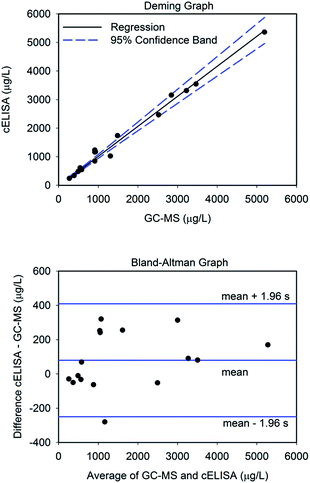 | ||
| Fig. 5 Deming regression and Bland–Altman graphs between mAb FDn#23-based cELISA and GC-MS analytical methods. | ||
4 Conclusions
A collection of mAbs against the fungicide fludioxonil has been produced for the first time and employed in the development of a highly sensitive immunoassay for residue determination. Among 6 antibodies with IC50 values in the low μg L−1 range, the highest sensitivity was obtained using mAb FDn#23 in the indirect cELISA format, so this assay was applied to the analysis of fludioxonil residues in fruit juices. The assay has been validated in terms of sensitivity, selectivity, trueness, and precision. After optimization and validation, a LOQ for fludioxonil of 5 and 10 μg L−1 was achieved for apple juice and red grape must, respectively. The proposed immunoassay was robust, and results on blind-spiked samples were statistically comparable to those provide by a reference chromatographic methodology.Acknowledgements
This work was supported by the Spanish Ministerio de Ciencia e Innovación (AGL2009-12940-C02-01-02/ALI) and cofinanced by FEDER funds. J.V.M. was hired by the Consejo Superior de Investigaciones Científicas (CSIC) under a Ramón y Cajal contract financed by Ministerio de Ciencia e Innovación and the European Social Fund. We acknowledge support of the publication fee by the CSIC Open Access Publication Support Initiative through its Unit of Information Resources for Research (URICI). We thank Alba Jiménez-Cuesta for her technical assistance.References
- European Food Safety Authority, EFSA J., 2011, 9, 2335 Search PubMed
.
- P. Leroux, Pestic. Sci., 1996, 47, 191–197 CrossRef CAS
.
- D. Errampalli, Crop Prot., 2004, 23, 811–817 CrossRef CAS PubMed
.
- European Food Safety Authority, EFSA J., 2013, 11, 3130 Search PubMed
.
- T. Rodríguez-Cabo, I. Rodríguez, M. Ramil and R. Cela, J. Chromatogr. A, 2011, 1218, 6603–6611 CrossRef PubMed
.
- K. G. Lee and E. K. Jo, Food Chem., 2012, 134, 2497–2503 CrossRef CAS PubMed
.
- J. Kovacova, V. Hrbek, J. Kloutvorova, V. Kocourek, L. Drabova and J. Hajslova, Food Addit. Contam., Part A, 2013, 30, 2123–2135 CrossRef CAS PubMed
.
- F. Cus, B. Bach, L. Barnavon and V. Z. Pongrac, Food Control, 2013, 33, 274–280 CrossRef CAS PubMed
.
- S. Sungur and C. Tunur, Food Addit. Contam., Part B, 2012, 5, 265–267 CrossRef CAS PubMed
.
- V. C. Fernandes, V. F. Domingues, N. Mateus and C. Delerue-Matos, Environ. Sci. Pollut. Res., 2012, 19, 4184–4192 CrossRef CAS PubMed
.
- F. A. Esteve-Turrillas, J. Parra, A. Abad-Fuentes, C. Agulló, A. Abad-Somovilla and J. V. Mercader, Anal. Chim. Acta, 2010, 682, 93–103 CrossRef CAS PubMed
.
- X. X. Jiang, H. Y. Shi, N. Wu and M. H. Wang, Food Chem., 2011, 125, 1385–1389 CrossRef CAS PubMed
.
- F. A. Esteve-Turrillas, A. Abad-Fuentes and J. V. Mercader, Food Chem., 2011, 124, 1727–1733 CrossRef CAS PubMed
.
- E. Watanabe and S. Miyake, Food Chem., 2013, 136, 695–702 CrossRef CAS PubMed
.
- J. V. Mercader, R. López-Moreno, F. A. Esteve-Turrillas, C. Agulló, A. Abad-Somovilla and A. Abad-Fuentes, J. Agric. Food Chem., 2014, 62, 2816–2821 CrossRef CAS PubMed
.
- E. Plana, M. J. Moreno, A. Montoya and J. J. Manclús, Food Chem., 2014, 143, 205–213 CrossRef CAS PubMed
.
- A. Abad-Fuentes, C. Agulló, F. A. Esteve-Turrillas, A. Abad-Somovilla and J. V. Mercader, J. Agric. Food Chem., 2014, 62, 2742–2744 CrossRef CAS PubMed
.
- J. V. Mercader, C. Suárez-Pantaleón, C. Agulló, A. Abad-Somovilla and A. Abad-Fuentes, J. Agric. Food Chem., 2008, 56, 7682–7690 CrossRef CAS PubMed
.
- S. J. Lehotay, J. AOAC Int., 2007, 90, 485–520 CAS
.
- European Union Pesticide Database, http://ec.europa.eu/sanco_pesticides.
| This journal is © The Royal Society of Chemistry 2014 |

